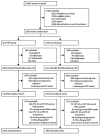Efficacy of a bivalent HPV 16/18 vaccine against anal HPV 16/18 infection among young women: a nested analysis within the Costa Rica Vaccine Trial
- PMID: 21865087
- PMCID: PMC3172992
- DOI: 10.1016/S1470-2045(11)70213-3
Efficacy of a bivalent HPV 16/18 vaccine against anal HPV 16/18 infection among young women: a nested analysis within the Costa Rica Vaccine Trial
Erratum in
- Lancet Oncol. 2011 Nov;12(12):1096
Abstract
Background: Anal cancer remains rare (incidence of about 1·5 per 100,000 women yearly), but rates are increasing in many countries. Human papillomavirus (HPV) 16 and 18 infections cause most cases of anal cancer. We assessed efficacy of an AS04-adjuvanted HPV 16 and HPV 18 vaccine against anal infection with HPV 16, HPV 18, or both (HPV 16/18).
Methods: Women from Costa Rica were registered between June 28, 2004, and Dec 21, 2005, in a randomised double-blind controlled trial that was designed to assess vaccine efficacy against persistent cervical HPV 16/18 infections and associated precancerous lesions. Eligible women were residents of Guanacaste and selected areas of Puntarenas, Costa Rica, age 18-25 years, in good general health, willing to provide informed consent, and were not pregnant or breastfeeding. Participants were randomly assigned (1:1) to receive an HPV vaccine (Cervarix, GlaxoSmithKline, Rixensart, Belgium) or a control hepatitis A vaccine (modified preparation of Havrix, GlaxoSmithKline, Rixensart, Belgium). Vaccines were administered in three 0·5 mL doses at enrolment, 1 month, and 6 months. Women, selected at the final blinded study visit 4 years after vaccination, provided anal specimens for assessment of vaccine efficacy against anal HPV 16/18 infection. Prevalence of anal HPV 16/18 infections, reported as vaccine efficacy, was the primary endpoint of the study described here. Vaccine efficacy against cervical HPV 16/18 infection in the same women at the 4-year visit was used as a comparator. Analyses were done in a restricted cohort of women who were negative for both cervical HPV 16 and HPV 18 DNA and who were HPV 16 and HPV 18 seronegative before enrolment (HPV naive), and also in the full cohort of women who provided an anal specimen. Investigators were masked to group assignment. This study is registered at ClinicalTrials.gov, number NCT00128661.
Findings: All women who attended the final blinded study visit and consented to anal specimen collection were included in the analysis (4210 of 6352 eligible women). In the full cohort, vaccine efficacy against prevalent HPV 16/18 infection measured one-time, 4 years post vaccination was lower at the anus (62·0%, 95% CI 47·1-73·1) compared with the cervix (76·4%, 67·0-83·5; p for interaction by anatomical site 0·031). In the restricted cohort, vaccine efficacy against anal HPV 16/18 infection was 83·6% (66·7-92·8), which was similar to vaccine efficacy against cervical HPV 16/18 infection (87·9%, 77·4-94·0). Safety issues were not addressed in the current analysis. Additional safety data will be published later in a separate article.
Interpretation: The AS04-adjuvanted vaccine affords strong protection against anal HPV infection, particularly among women more likely to be HPV naive at enrolment.
Funding: National Cancer Institute with contributions from the National Institutes of Health Office of Research on Women's Health. Vaccine was provided by GlaxoSmithKline Biologicals.
Copyright © 2011 Elsevier Ltd. All rights reserved.
Conflict of interest statement
We declare that we have no conflicts of interest.
Figures

Comment in
-
Who should be targeted for vaccination against anal cancer?Lancet Oncol. 2011 Sep;12(9):828-9. doi: 10.1016/S1470-2045(11)70237-6. Epub 2011 Aug 22. Lancet Oncol. 2011. PMID: 21865086 No abstract available.
References
-
- Stewart BW, Kleihues P, editors. IARC-WHO 2003. World Cancer Report. International Agency for Research on Cancer and World Health Organization; Geneve: Suisse: 2003.
-
- Johnson LG, Madeleine MM, Newcomer LM, Schwartz SM, Daling JR. Anal cancer incidence and survival: the surveillance, epidemiology, and end results experience, 1973-2000. Cancer. 2004;101(2):281–288. - PubMed
-
- Maggard MA, Beanes SR, Ko CY. Anal canal cancer: a population-based reappraisal. Dis Colon Rectum. 2003;46(11):1517–1523. - PubMed
-
- Nielsen A, Munk C, Kjaer SK. Trends in incidence of anal cancer and high-grade anal intraepithelial neoplasia in Denmark, 1978-2008. Int J Cancer. 2011 - PubMed
Publication types
MeSH terms
Substances
Associated data
Grants and funding
LinkOut - more resources
Full Text Sources
Medical
Research Materials

